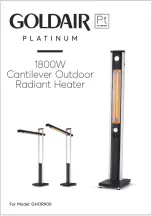
14
Electrical Connections
Before any electrical connections are made, be sure that the water heater is
full of water and that the manual shut-off valve in the cold water supply line is
open. If the heating elements are not completely immersed in water at all
times, they will be damaged (burned-out) if energized for even a short period of
time. The warranty does not cover burned-out heating elements. Check the
rating plate and wiring diagram before proceeding. This electric water heater
was built and wired in accordance with the Underwriters Laboratories testing
approvals requirements. The temperature-limiting device is of the manual
reset, trip-free type and has been factory installed to interrupt all ungrounded
power supply conductors in the event of thermostat failure. The plumbing
supplier in your area ordered this water heater wired at the factory to comply
with existing area codes, but local utility codes may require or allow other
circuitry. Consult your local power company to determine the correct electrical
hook-up in order to meet local utility and building codes and in order to obtain
the most economical rates. All electrical connections to elements,
thermostats, and contactors (certain models) have been made at the factory.
DO NOT
alter any of the internal wiring. Wiring connections may loosen
during shipment. Check all connections for tightness.
To make the wiring connections to a power supply, follow the steps below.
A) Open cover door of the control box.
B) Bring the power leads from an adequately fused disconnect switch
(not
furnished with the water heater due to varying state and local
codes) and
connect to the terminal block. Where long runs, local
ordinances or utility
company necessitates, an increase in size may be
required.
C) This water heater must be properly grounded. A ground lug is provided
within the electrical control box for connection to a properly
sized
ground. (See wiring diagram for minimum required ground size. Wiring
diagram is located on the inside door of the control box)
D) Close cover door of the control box.
Heating Elements
To replace heating elements, disconnect power to the water heater, drain tank
and replace element. To remove a heating element, use a 1 1/2” screw type
element wrench available from most supply houses.
Do not
over-tighten the
new element, as this will cause distortion in the new element gasket. Once
the element has been replaced, follow the instructions “To Fill The Water
Heater”. It is imperative that the water heater is full before power is restored to
the heating elements.
Electrical Connections continued-
Amperage Chart
INTERNET VERSION FOR REFERENCE ONLY









































